- Zodiac Heads by Ai Weiwei, 2011. Rabbit first on left.
- Tim Button’s rabbit in Alice in Wonderland, 2010
- Peter Rabbit by Beatrix Potter, 1901
- Bugs Bunny for Looney Tunes by Warner Brothers
- Playboy Bunnies.
- Rabbit, Jeff Koons, Thanksgiving Day Parade, NYC, 2007. Photo NY Times
- Jeff Koons, Rabbit, 2009, Covent Garden Market, London
- Hase by Gelitin, Installed 2005, Conceived 1991, Knitting Started in 1999. 200 feet. Wool and hay.
- Hase by Gelitin, Installed 2005, Conceived 1991, Knitting Started in 1999. 200 feet. Wool and hay.
- Stor Gul Kanin by Florentijin Hofman, Örebro, Sweden, 2011
- Stor Gul Kanin by Florentijin Hofman, Örebro, Sweden, 2011
- Lawrence Argent, “Leap” 2011. Sacramento Airport. 56 ft long. Photo – Ed Asmus
- Lawrence Argent, “Leap” 2011. Sacramento Airport. 56 ft long. Photo – Ed Asmus
- Joseph Bueys, How to Explain Pictures to a Dead Hare, 1965
- Actual Giant Rabbit from Germany.
- Hase by Gelitin, Decay by 2007, Italian Alps
- Hase by Gelitin, Decay by 2008, Italian Alps
- Miffy Fountain by Tom Sachs, 2008
- Giant Rabbits, Cracking Art Group, Brussels, 2009
- Rabbit from 30,000 Plates, The Porcelain City, Jingdezhen City, China, 2011
- Rabbit mural by ROA in London, 2008
- Rabbit mural by ROA in London, 2010
- Barry Flanagan, Leaping Rabbit, 1980s.
- Sophie Ryder, The Lady Hare, UK.
For some reason, giant rabbits have entered the public art universe in the last six years. Koons, Hofman, Gelitin, Argent and others have installed silver, yellow, pink and red sculptures where 50 feet is the minimum. They float in the sky or lay uncomfortably in the stone plaza or grassy mountain top. Hofman’s “Stor Gul Kanin” lived once in Sweden. Koon’s “Rabbit” appears and reappears in festivals or parades. Gelitin’s “Hase” decomposes in the Italian alps. Argent’s faceted “Leap” hangs as a single stop-action frame above the airport baggage claim in California.
Who cares about rabbits? In Ai WeiWei’s Zodiac Heads, the rabbit appears un-carved without any energy. The person born in the Year of the Rabbit has a pleasant calm and joyful personality without much ambition.
The rabbit is part of many mythologies, but never significant to core the religion or culture. The rabbit signals fertility, thus the phrase “Multiply like rabbits”. A single pair of rabbits of breeding rabbits can result in more than 1000 new rabbits in 12 months compared to only 150 rats. Early Lutherans invented the Easter bunny as a kind of Santa Claus rewarding children for good behavior. A rabbit’s foot is good luck.
Two periods of rabbit admiration exist: the late 19th Century and Post WWII. Lewis Carroll’s Alice follows the time keeping rabbit into Wonderland. The African and Cherokee “Br’er Rabbit” slave tales are published by Joel Chandler Harris in 1880. Beatrix Potter invents the badly behaving Peter the Rabbit in 1901.
Animation revives the stories. Walt Disney retells Br’er Rabbit and Alice’s rabbit in major animated features in 1946 and 1951. Bugs Bunny begins his decades of Looney Tune shorts in 1941. Jimmy Stewart engages his imaginary 6’-3“ rabbit in “Harvey” and General Mills broadcasts the rabbit who perpetually fails to steal Trix breakfast cereal. The 1950s ends with the opening of the first Playboy Club and the waitress Bunnies.
Most of the storytellers, authors and animators draw the rabbit a relaxed character that can be slightly clever – outsmarting his opponents or himself. Rabbits are never threatening and don’t want to be threatening. Floppiness is the prime physical adjective.
So here we are – a series of artists focused on an artistic history for children. Jeff Koons remakes a child’s balloon animal, Gelitin – a dropped sock doll, and Florentijn Hofman – a tossed stuffed animal. Gelitin and Hofman are passive and only engage due to scale. Through the changing reflections on the floating Mylar rabbit, Koons escapes the passivity, but not the intentional banality. None of them wish to touch the imagery of Potter or Disney.
Is there a value in presenting the emptiness of symbol? To feel the nothing in face of the something? While cleverly presenting a non-threatening bunny, is the artistic result depression as the rabbit “incarnates itself in the earth” as Joseph Bueys wrote for his 1965 performance, “How to Explain Pictures to a Dead Hare.”
Lawrence Argent’s “Leap” avoids being swallowed whole by passivity, darkness and cartoons. The red rabbit mixes images from National Geographic with the escapes of Peter Rabbit and Br’er Rabbit, the start of the race against the tortoise and the jump down the rabbit hole from Alice in Wonderland. The freeze frame of the leap strives to retain the energy of motion found in traditional sculpture. From my computer screen, I cannot tell that if it succeeds, but it lacks something of the internal energy of Barry Flanagan’s leaping rabbits from the 1980s.
Details…………………….
Gelitin, “Hase”, installed 2005, conceived 1991, knitted beginnning in 1999, decaying until 2050. Italian Alps. 200 feet. Wool and hay.
Jeff Koons, “Rabbit”, 2007, NYC Thanksgiving Day Parade. Balloon. 50 Feet . Koons’ first mylar easter bunny was made in 1986.
Lawrence Argent, “Leap”, 2011. Sacramento California Airport, 56-foot by 19-foot. Painted aluminum. Suspended by cables.
Florentijn Hofman, “Stor Gul Kanin”, Örebro, Sweden, 2011. 13 x 16 x 16 meters. Concrete, metal, wood and takspån.
Other Rabbits……………………………………………………….
Ai Weiwei, “Zodiac Heads,” 2011. Bronze. Currently at Princeton University. Coming to Cleveland Museum of Art and Miami Art Museum in 2013.
Tom Sachs, “Miffy Fountain”, 2008. Bronze. 9 feet tall.
Cracking Art Group, “Rabbits”, Brussels, 2009
Giant rabbit sculpture made of 30,000 porcelain plates in the People’s Square in Jingdezhen City in 2011. Jingdezhen is the “Porcelain Capital” of China.
ROA, Several Rabbits, London, 2008 & 2010
Sophie Ryder, Lady Hares, 1990 – 2000s. Wire Sculpture
Missed Rabbits in First Post……………………………………………..
Mr. Clements, Sad Bunnies
Energizer Bunny
More Florentijn Hofman Rabbits
………………………………………………………………………………………………………..
From Sean Capone. He maintains a Facebook album of rabbits in artworks
Weiss Question to Sean: What are the prime reasons that artists use rabbits?
” That’s a really good question Glenn. When I started paying attention, I found a lot of work by artists who otherwise don’t deal in such subject matter, rabbits popping up in pieces almost at random, and continue to be surprised.
One of the interesting things you noted in your essay was that, even though rabbits are ubiquitous characters in many cultures, they are not CENTRAL to any mythos or belief system.
Maybe the rabbit is a kind of symbol for the artist archetype itself. Crafty, fecund, skittish, mercurial, intelligent, purity/innocence, willful, troublemakers, a character in a mythology but not a god itself.. and always the prey, never the hunter, way down on the food chain!
For me personally I find rabbits to be sexy (the jackrabbit/hare a ‘body type’ that I find very interesting). I had a childhood obsession with Watership Down, a bloody, sex-filled book, so my boyhood associations had nothing to do with cute bunnies.
Some kids had stuffed bunnies (symbol of innocence)-
Some kids viewed rabbits as game & as enemies (the farmer’s child)-
Religious associations (Easter, Native American culture)-
Bugs Bunny & Br’er Rabbit are very adult personalities (instigators, disruptors of authority) that reveal to kids how creativity can be deployed to resist power structures & adulthood.
You have to look at what TYPE of rabbit these artists are using to see where they’re coming from… Gelitin’s ‘plush bunny’ vs. Barry Flanagan’s ‘running hares’ vs. Adam Fuss’ ‘rabbit entrail photograms’, are all different expressions, from a symbolic standpoint.”
Written by Sean Capone, May 22, 2013.

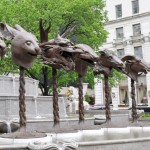
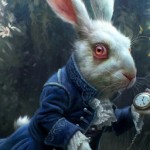
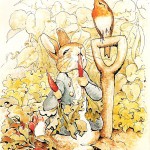
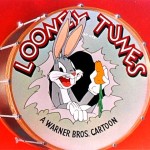
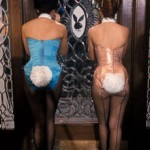
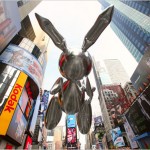
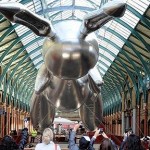
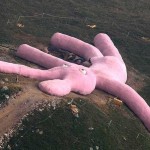
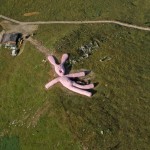
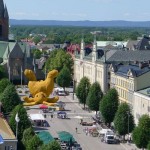
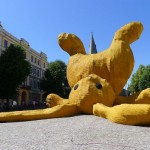
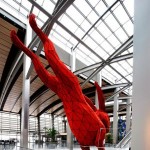
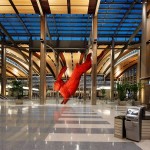
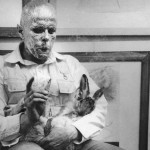
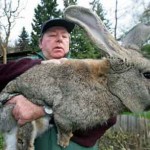
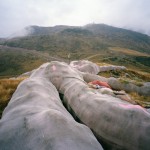
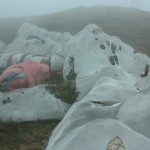
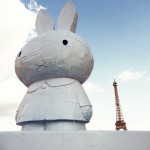
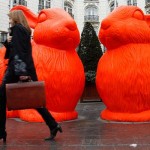
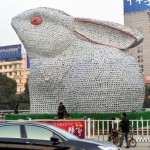
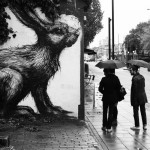
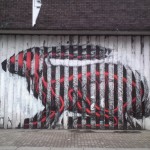
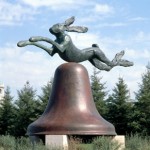

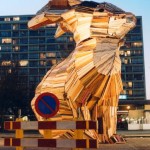
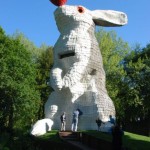
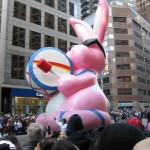
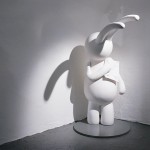
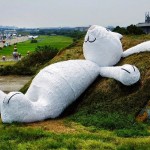
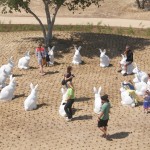
Last year I was a juror for a major regional grant program to artists- I looked at the work of hundreds of artists. While there were, indeed, a few rabbits, they were far outnumbered by Birds- probably well over 100 artists used birds as their main subject matter.
Maybe its a regional thing- after all, I dont live all that far from Portlandia…
But I think, in general, small, non-threatening animals have been a good 25% of artworks for decades, if not centuries.